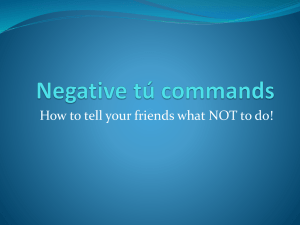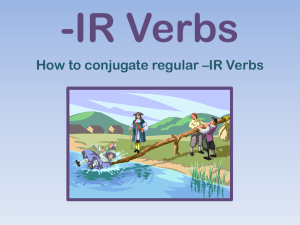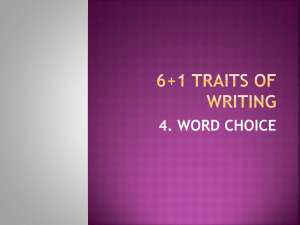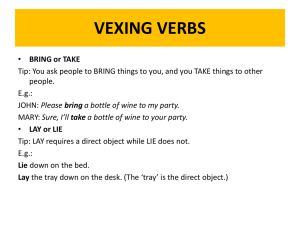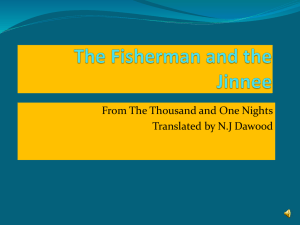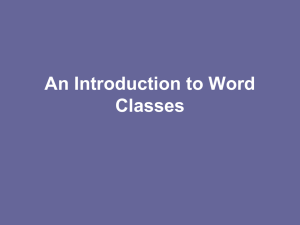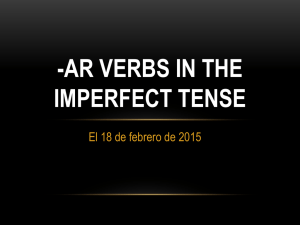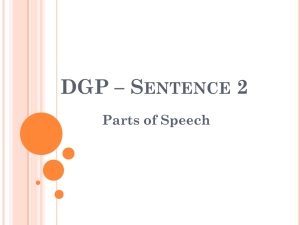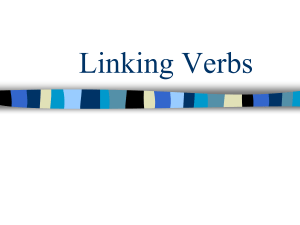Two Sentence Patterns Built on Action Verbs
advertisement
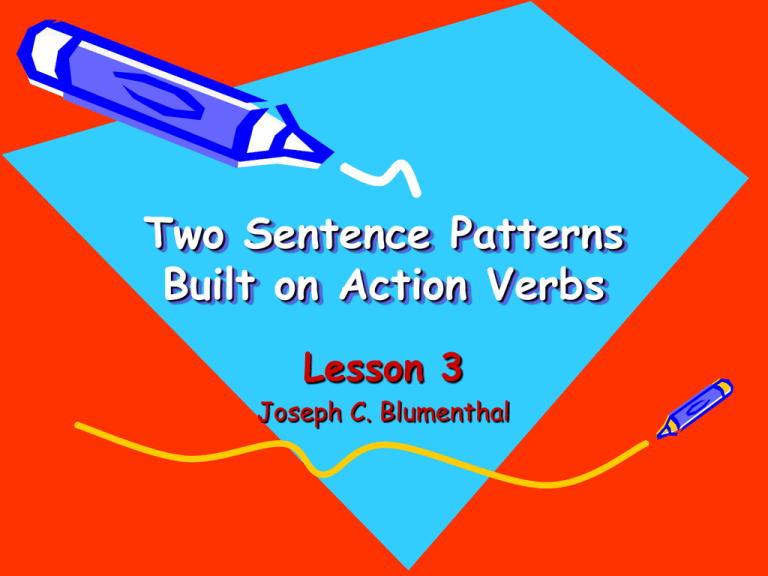
Two Sentence Patterns Built on Action Verbs Lesson 3 Joseph C. Blumenthal Two Sentence Patterns Built on Action Verbs • Nearly every simple sentence that we make falls into one of three basic patterns. Two of these patterns involve action verbs. Choose the one verb which indicates action. was pushed seemed Two Sentence Patterns Built on Action Verbs • Nearly every simple sentence that we make falls into one of three basic patterns. Two of these patterns involve action verbs. Choose the one verb which indicates action. was pushed seemed Two Sentence Patterns Built on Action Verbs • Some action verbs indicate actions of the body; others indicate actions of the mind. a.worked, drove washed, wrote, lifted b.thought, hoped, believed, decided, understood Which group of verbs indicates actions of the mind? Two Sentence Patterns Built on Action Verbs • Some action verbs indicate actions of the body; others indicate actions of the mind. a.worked, drove washed, wrote, lifted b.thought, hoped, believed, decided, understood Which group of verbs indicates actions of the mind? Two Sentence Patterns Built on Action Verbs • Action verbs can sometimes make complete statements about their subjects without the need of any other words. a. Harvey stumbled b. Harvey sharpened Does the action verb make a complete statement about its subject in a or b? Two Sentence Patterns Built on Action Verbs • Action verbs can sometimes make complete statements about their subjects without the need of any other words. a. Harvey stumbled. b. Harvey sharpened. Does the action verb make a complete statement about its subject in a or b? Two Sentence Patterns Built on Action Verbs a. Our guest brought b. Our guest arrived Does the action verb make a complete statement about its subject in a or b? Two Sentence Patterns Built on Action Verbs a. Our guest brought b. Our guest arrived Does the action verb make a complete statement about its subject in a or b? Two Sentence Patterns Built on Action Verbs • The action verb that makes a complete statement about its subject gives us our first sentence pattern: PATTERN I: Subject-Action Verb a. Our guest brought… b. Our guest arrived. Which word group represents Pattern I? Two Sentence Patterns Built on Action Verbs • The action verb that makes a complete statement about its subject gives us our first sentence pattern: PATTERN I: Subject-Action Verb a. Our guest brought… b. Our guest arrived. Which word group represent Pattern I? Two Sentence Patterns Built on Action Verbs • Any sentence is Pattern I if the action verb by itself makes a complete statement about its subject—no matter how many other words and phrases may be present. a. Our guest arrived. b. Our guest from Ohio arrived by plane this morning. Both a and b are Pattern I sentences. (true, false) Two Sentence Patterns Built on Action Verbs • Any sentence is Pattern I if the action verb by itself makes a complete statement about its subject—no matter how many other words and phrases may be present. a. Our guest arrived. b. Our guest from Ohio arrived by plane this morning. Both a and b are Pattern I sentences. (true, false) Two Sentence Patterns Built on Action Verbs Our guest from Ohio arrived by plane this morning. This is a Pattern I sentence because Our guest arrived is (complete, incomplete) in its meaning. Two Sentence Patterns Built on Action Verbs Our guest from Ohio arrived by plane this morning. This is a Pattern I sentence because Our guest arrived is (complete, incomplete) in its meaning. Two Sentence Patterns Built on Action Verbs a.The coaches agreed with each other. b. The coaches compared the two teams. Read just the subject and verb in each sentence, omitting the words that follow them. Which sentence is Pattern I because the verb by itself can make a statement about its subject that is complete in meaning? Two Sentence Patterns Built on Action Verbs a.The coaches agreed with each other. b. The coaches compared the two teams. Read just the subject and verb in each sentence, omitting the words that follow them. Which sentence is Pattern I because the verb by itself can make a statement about its subject that is complete in meaning? a. Two Sentence Patterns Built on Action Verbs a. The coaches agreed b. The coaches compared Which group of words requires the addition of other words to complete its meaning? Two Sentence Patterns Built on Action Verbs a. The coaches agreed b. The coaches compared. Which group of words requires the addition of other words to complete its meaning? b Two Sentence Patterns Built on Action Verbs The coaches compared...(What?) What did the coaches compare—the fans, the stadiums, or the teams? We don’t know. Until we answer this question, them meaning of the sentence is (complete, incomplete). Two Sentence Patterns Built on Action Verbs The coaches compared...(What?) What did the coaches compare—the fans, the stadiums, or the teams? We don’t know. Until we answer this question, them meaning of the sentence is (complete, incomplete). Two Sentence Patterns Built on Action Verbs The coaches compared the two teams. Now we know what the coaches compared, and the meaning of our sentence is complete. Which word follows the verb compared to complete the meaning of the sentence? What did they compare? _______ Two Sentence Patterns Built on Action Verbs The coaches compared the two teams. Now we know what the coaches compared, and the meaning of our sentence is complete. Which word follows the verb compared to complete the meaning of the sentence? What did they compare? teams Two Sentence Patterns Built on Action Verbs A word that follows a verb and completes the meaning of a sentence is known as a complement, which is the grammar name for a completer. A complement, or completer, is sometimes needed after a verb to _______the meaning of a sentence. Two Sentence Patterns Built on Action Verbs A word that follows a verb and completes the meaning of a sentence is known as a complement, which is the grammar name for a completer. A complement, or completer, is sometimes needed after a verb to complete the meaning of a sentence. Two Sentence Patterns Built on Action Verbs The police blocked the road. Because the noun road is needed to complete the meaning of this sentence, it is a . Two Sentence Patterns Built on Action Verbs The police blocked the road. Because the noun road is needed to complete the meaning of this sentence, it is a complement or completer. Two Sentence Patterns Built on Action Verbs The kind of complement that receives the action of the verb or shows the result of this action is called a direct object. The teacher will correct the tests. Which word is a direct object because it receives the action of the verb will correct? Two Sentence Patterns Built on Action Verbs The kind of complement that receives the action of the verb or shows the result of this action is called a direct object. The teacher will correct the tests. Which word is a direct object because it receives the action of the verb will correct? tests Two Sentence Patterns Built on Action Verbs The cashier made a slight mistake. Which word is a direct object because it shows the result of the action of the verb made? Two Sentence Patterns Built on Action Verbs The cashier made a slight mistake. Which word is a direct object because it shows the result of the action of the verb made? mistake Two Sentence Patterns Built on Action Verbs a.The company manufactures trucks. b.The company repairs trucks. In one sentence, the trucks already exist and receive the action of the verb. Two Sentence Patterns Built on Action Verbs a.The company manufactures trucks. b.The company repairs trucks. In one sentence, the trucks already exist and receive the action of the verb. In the other, the trucks are the result of the action. Two Sentence Patterns Built on Action Verbs a.The company manufactures trucks. b.The company repairs trucks. In one sentence, the trucks already exist and receive the action of the verb. In the other, the trucks are the result of the action. The direct object receives the action in sentence (a, b). Two Sentence Patterns Built on Action Verbs a.The company manufactures trucks. b.The company repairs trucks. In one sentence, the trucks already exist and receives the action of the verb. In the other, the trucks are the result of the action. The direct object receives the action in sentence (a, b). Two Sentence Patterns Built on Action Verbs The sentence that contains a direct object gives us our second sentence pattern. PATTERN II: Subject—Action Verb Direct Object A sentence in Pattern II has three basic parts. The third basic part is the object. Two Sentence Patterns Built on Action Verbs The sentence that contains a direct object gives us our second sentence pattern. PATTERN II: Subject—Action Verb Direct Object A sentence in Pattern II has three basic parts. The third basic part is the direct object. Two Sentence Patterns Built on Action Verbs PATTERN II: The speaker showed a movie of his travels. Notice that the action begins with the subject and ends with the direct object. The direct object of an action verb is the goal of its action. Which word is the direct object in the example above? Two Sentence Patterns Built on Action Verbs PATTERN II: The speaker showed a movie of his travels. Notice that the action begins with the subject and ends with the direct object. The direct object of an action verb is the goal of its action. Which word is the direct object in the example above? movie Two Sentence Patterns Built on Action Verbs Don’t mistake another word that may follow an action verb for a direct object. To be a direct object, a word must either receive the action of the verb or show the result of the . Two Sentence Patterns Built on Action Verbs Don’t mistake another word that may follow an action verb for a direct object. To be a direct object, a word must either receive the action of the verb or show the result of the action. Two Sentence Patterns Built on Action Verbs a.Mr. Price returned recently. b. Mr. Price returned money. Does the word recently or money receive the action of the verb returned? (Hint: which one could you physically return?) Two Sentence Patterns Built on Action Verbs a.Mr. Price returned recently. b. Mr. Price returned money. Does the word recently or money receive the action of the verb returned? Money (Hint: which one could you physically return?) Two Sentence Patterns Built on Action Verbs a.Mr. Price returned recently. b. Mr. Price returned money. So which sentence contains a direct object that receives action? Two Sentence Patterns Built on Action Verbs a.Mr. Price returned recently. b. Mr. Price returned money. So which sentence contains a direct object that receives action? b. Two Sentence Patterns Built on Action Verbs a. The rain stopped the game. b. The rain stopped suddenly. Which sentence contains a direct object? Two Sentence Patterns Built on Action Verbs a. The rain stopped the game. b. The rain stopped suddenly. Which sentence contains a direct object? a Two Sentence Patterns Built on Action Verbs Pattern I is built around a two-part framework: a subject and an action verb. Pattern II is built around a three-part framework: a subject, an action verb, and a . Two Sentence Patterns Built on Action Verbs Pattern I is built around a two-part framework: a subject and an action verb. Pattern II is built around a three-part framework: a subject, an action verb, and a direct object. Two Sentence Patterns Built on Action Verbs a.All good citizens vote on Election Day. b.All good citizens cast their vote on Election Day. Which sentence is Pattern II because the verb is followed by a direct object? Two Sentence Patterns Built on Action Verbs a.All good citizens vote on Election Day. b.All good citizens cast their vote on Election Day. Which sentence is Pattern II because the verb is followed by a direct object? Two Sentence Patterns Built on Action Verbs a.All good citizens vote on Election Day. b.All good citizens cast their vote on Election Day. Which sentence is Pattern II because the verb is followed by a direct object? Two Sentence Patterns Built on Action Verbs a.Each student keeps a list of every misspelled word. b.The wheezing motor finally stopped completely. Which sentence is Pattern II because the verb is followed by a direct object? Two Sentence Patterns Built on Action Verbs a.Each student keeps a list of every misspelled word. b.The wheezing motor finally stopped completely. Which sentence is Pattern II because the verb is followed by a direct object? Two Sentence Patterns Built on Action Verbs The pitcher threw Reggie a fast curve. After the verb threw, we have two nouns—Reggie and curve. To decide which is the direct object, ask yourself, “What did the pitcher throw?” The direct object is the noun Two Sentence Patterns Built on Action Verbs The pitcher threw Reggie a fast curve. After the verb threw, we have two nouns—Reggie and curve. To decide which is the direct object, ask yourself, “What did the pitcher throw?” The direct object is the noun curve. Two Sentence Patterns Built on Action Verbs The pitcher threw Reggie a fast curve. What does the noun Reggie do? It shows to whom the pitcher threw the curve. We call such a noun (or pronoun) an indirect object. Curve is the direct object; Reggie is the object. Two Sentence Patterns Built on Action Verbs The pitcher threw Reggie a fast curve. What does the noun Reggie do? It shows to whom the pitcher threw the curve. We call such a noun (or pronoun) an indirect object. Curve is the direct object; Reggie is the indirect object. Two Sentence Patterns Built on Action Verbs The pitcher threw Reggie a fast curve. The indirect object Reggie comes (before, after) the direct object curve. Two Sentence Patterns Built on Action Verbs The pitcher threw Reggie a fast curve. The indirect object Reggie comes (before, after) the direct object curve. Two Sentence Patterns Built on Action Verbs a.The pitcher threw Reggie a fast curve. b.The pitcher threw him a fast curve. In which sentence is the indirect object not a noun but a pronoun? Two Sentence Patterns Built on Action Verbs a.The pitcher threw Reggie a fast curve. b.The pitcher threw him a fast curve. In which sentence is the indirect object not a noun but a pronoun? Two Sentence Patterns Built on Action Verbs An indirect object can show to what, as well as to whom, something was done. These shoes give my feet more support. The noun support is the The noun feet is the object. object. Two Sentence Patterns Built on Action Verbs An indirect object can show to what, as well as to whom, something was done. These shoes give my feet more support. The noun support is the direct object. The noun feet is the object. Two Sentence Patterns Built on Action Verbs An indirect object can show to what, as well as to whom, something was done. These shoes give my feet more support. The noun support is the direct object. The noun feet is the indirect object. Two Sentence Patterns Built on Action Verbs Besides showing to whom (or to what) something was done, an indirect object can also show for whom (or for what) something was done. Cindy Yazzing sang us a song. For whom did Cindy Yazzie sing? For Two Sentence Patterns Built on Action Verbs Besides showing to whom (or to what) something was done, an indirect object can also show for whom (or for what) something was done. Cindy Yazzing sang us a song. For whom did Cindy Yazzie sing? For us. Two Sentence Patterns Built on Action Verbs Cindy Yazzing sang us a song. The direct object is The indirect object is Two Sentence Patterns Built on Action Verbs Cindy Yazzing sang us a song. The direct object is song. The indirect object is Two Sentence Patterns Built on Action Verbs Cindy Yazzing sang us a song. The direct object is song. The indirect object is us. Two Sentence Patterns Built on Action Verbs Cindy Yazzing sang us a song. As it always does when it is present, the indirect object comes (before, after) the direct object. Two Sentence Patterns Built on Action Verbs Cindy Yazzing sang us a song. As it always does when it is present, the indirect object comes (before, after) the direct object. Two Sentence Patterns Built on Action Verbs The club bought the church a new organ. The direct object is the noun . (Hint: what did the church buy?) The indirect object is the noun (Hint: for whom did they buy it?) . Two Sentence Patterns Built on Action Verbs The club bought the church a new organ. The direct object is the noun organ. (Hint: what did the church buy?) The indirect object is the noun (Hint: for whom did they buy it?) . Two Sentence Patterns Built on Action Verbs The club bought the church a new organ. The direct object is the noun organ. (Hint: what did the church buy?) The indirect object is the noun church. (Hint: for whom did they buy it?) Two Sentence Patterns Built on Action Verbs An indirect object shows to whom or what or whom or what something is done. Two Sentence Patterns Built on Action Verbs An indirect object shows to whom or what or for whom or what something is done. Two Sentence Patterns Built on Action Verbs An indirect object—if one is present— always comes before the direct object, and the word to or for is understood but never used. a.I offered Frank my ticket. b.I offered my ticket to Frank. Is Frank an indirect object in sentence a or b? Two Sentence Patterns Built on Action Verbs An indirect object—if one is present— always comes before the direct object, and the word to or for is understood but never used. a.I offered Frank my ticket. b.I offered my ticket to Frank. Is Frank an indirect object in sentence a or b? Two Sentence Patterns Built on Action Verbs An indirect object tells to whom or for whom by its position alone—by coming before the direct object. A noun or pronoun used with to or for is never an indirect object. a.Jan found a better job for her friend. b.Jan found her friend a better job. Is freind an indirect object in sentence a or b? Two Sentence Patterns Built on Action Verbs An indirect object tells to whom or for whom by its position alone—by coming before the direct object. A noun or pronoun used with to or for is never an indirect object. a.Jan found a better job for her friend. b.Jan found her friend a better job. Is freind an indirect object in sentence a or b? Two Sentence Patterns Built on Action Verbs a.This machine will save much time. b.This machine will save the company much time. The noun time is the direct object in both sentences. Which sentence also contains an indirect object? Two Sentence Patterns Built on Action Verbs a.This machine will save much time. b.This machine will save the company much time. The noun time is the direct object in both sentences. Which sentence also contains an indirect object? b Two Sentence Patterns Built on Action Verbs Father made the boys some sandwiches. The direct object is The indirect object is Two Sentence Patterns Built on Action Verbs Father made the boys some sandwiches. The direct object is sandwiches. The indirect object is Two Sentence Patterns Built on Action Verbs Father made the boys some sandwiches. The direct object is sandwiches. The indirect object is boys. Two Sentence Patterns Built on Action Verbs A sentence in Pattern II always contains an action verb and its direct object. Does it always have to contain an indirect object? (Yes, No) Two Sentence Patterns Built on Action Verbs A sentence in Pattern II always contains an action verb and its direct object. Does it always have to contain an indirect object? (Yes, No) Two Sentence Patterns Built on Action Verbs In this and the following frames, S = Subject, V = Verb, IO = Indirect object, DO = Direct Object. Fill in the missing word: 1.This bakery makes the best doughnuts in town. S – bakery V – makes DO - Two Sentence Patterns Built on Action Verbs 2.Anyone can show you the way to the bridge. S – anyone V– DO – way IO - Two Sentence Patterns Built on Action Verbs 3. Franklin’s experiments with electricity brought him international fame. S – experiments V – brought DO – IO - Two Sentence Patterns Built on Action Verbs 4. The editor gave a better title to my article. S – editor V – gave DO – Two Sentence Patterns Built on Action Verbs 5. The editor gave my article a better title. S – editor V – gave DO – IO - You are done!!! Please turn in your answers for points.
